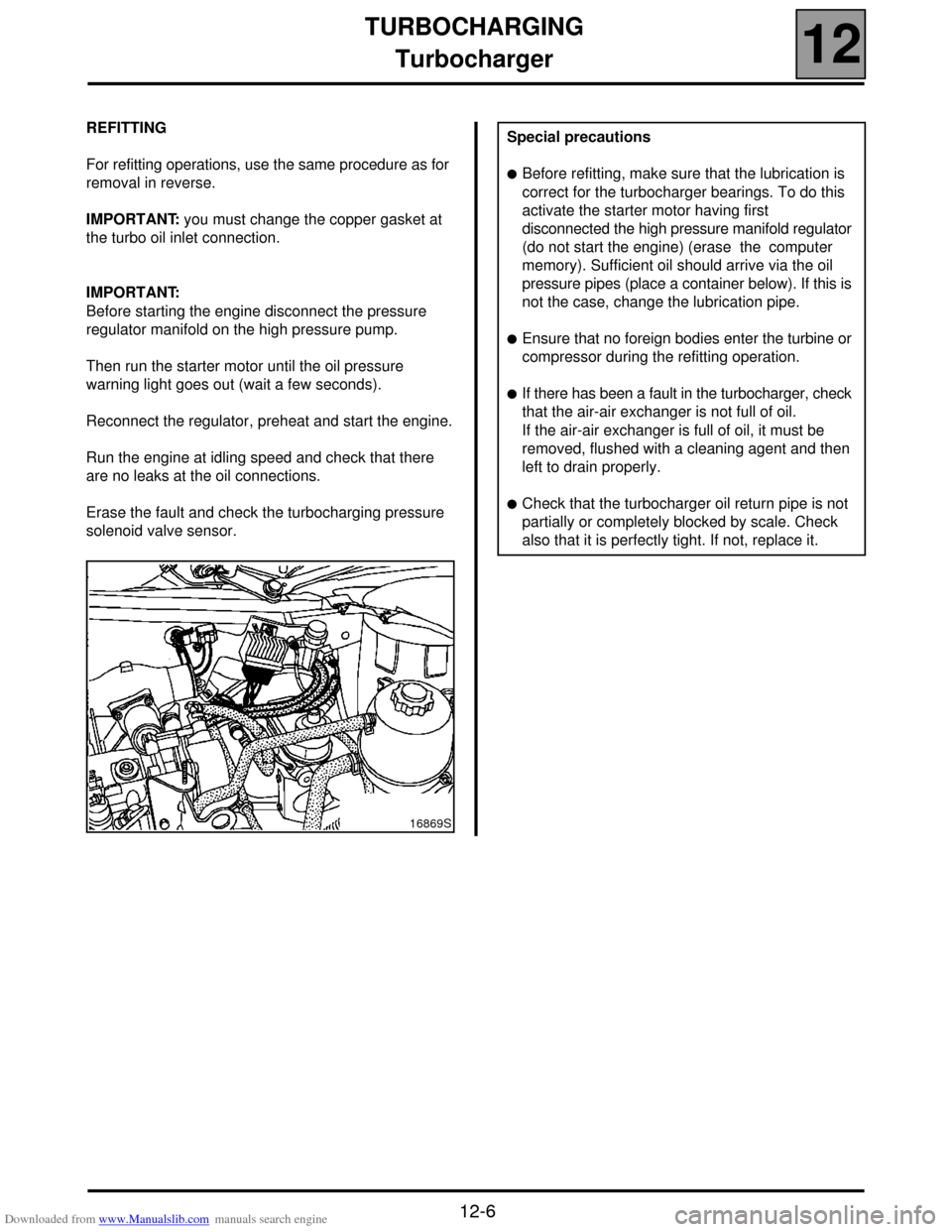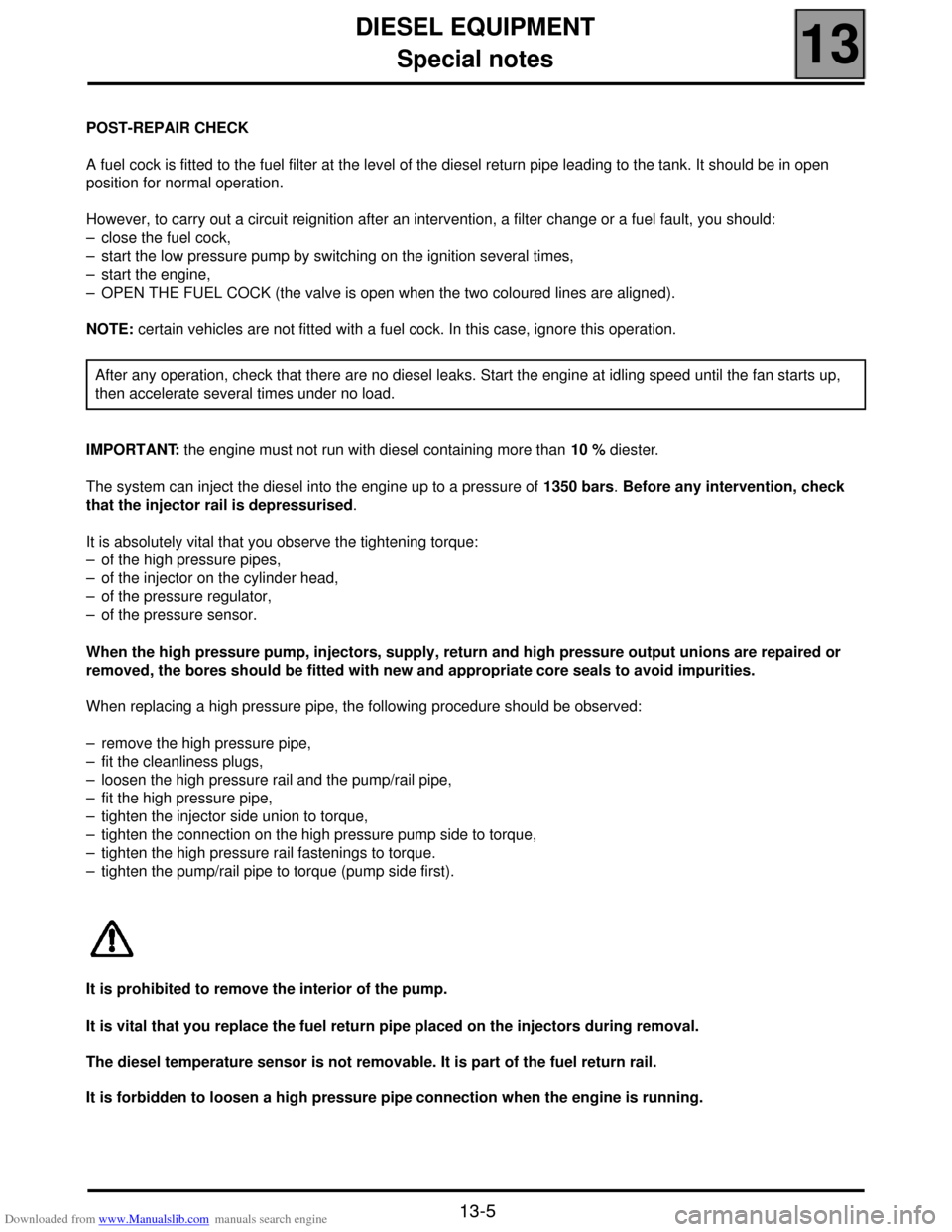Page 44 of 118

Downloaded from www.Manualslib.com manuals search engine TURBOCHARGING
Turbocharger
12
12-6
REFITTING
For refitting operations, use the same procedure as for
removal in reverse.
IMPORTANT: you must change the copper gasket at
the turbo oil inlet connection.
IMPORTANT:
Before starting the engine disconnect the pressure
regulator manifold on the high pressure pump.
Then run the starter motor until the oil pressure
warning light goes out (wait a few seconds).
Reconnect the regulator, preheat and start the engine.
Run the engine at idling speed and check that there
are no leaks at the oil connections.
Erase the fault and check the turbocharging pressure
solenoid valve sensor.
16869S
Special precautions
!Before refitting, make sure that the lubrication is
correct for the turbocharger bearings. To do this
activate the starter motor having first
disconnected the high pressure manifold regulator
(do not start the engine) (erase the computer
memory). Sufficient oil should arrive via the oil
pressure pipes (place a container below). If this is
not the case, change the lubrication pipe.
!Ensure that no foreign bodies enter the turbine or
compressor during the refitting operation.
!If there has been a fault in the turbocharger, check
that the air-air exchanger is not full of oil.
If the air-air exchanger is full of oil, it must be
removed, flushed with a cleaning agent and then
left to drain properly.
!Check that the turbocharger oil return pipe is not
partially or completely blocked by scale. Check
also that it is perfectly tight. If not, replace it.
Page 55 of 118

Downloaded from www.Manualslib.com manuals search engine DIESEL EQUIPMENT
Special notes
13
13-4
OPERATION
The common rail direct high pressure injection system is a sequential diesel injection system (based on the
operation of multipoint injection for petrol engines).
This new injection system reduces operating noise, lowers the quantity of polluting gas and particles and produces
significant engine torque at low engine speeds thanks to a pre-injection procedure.
The low pressure pump (also called the supercharging pump) supplies the HP pump, through the filter with pressure
of between 2.5 and 4 bars.
The HP pump generates the high pressure sent to the injection rail. The pressure regulator located on the pump
modulates the value of the high pressure via the computer. The rail supplies each injector through a steel pipe.
The computer:
– determines the value of injection pressure necessary for the engine to operate well and then controls the pressure
regulator. It checks that the pressure value is correct by analysing the value transmitted by the pressure sensor
located on the rail,
– determines the injection time necessary to deliver the right quantity of diesel and the moment when injection should
be started,
– controls each injector electrically and individually after determining these two values.
The injected flow to the engine is determined depending on:
– the duration of injector control,
– the injector opening and closing speed,
– the needle stroke (determined by the type of injector),
– the nominal injector hydraulic flow (determined by the type of injector),
– the high pressure rail pressure controlled by the computer.
FOR ANY INTERVENTION IN THE HIGH PRESSURE INJECTION SYSTEM YOU MUST RESPECT THE
CLEANING AND SAFETY ADVICE SPECIFIED IN THIS DOCUMENT.
Page 56 of 118

Downloaded from www.Manualslib.com manuals search engine DIESEL EQUIPMENT
Special notes
13
13-5
POST-REPAIR CHECK
A fuel cock is fitted to the fuel filter at the level of the diesel return pipe leading to the tank. It should be in open
position for normal operation.
However, to carry out a circuit reignition after an intervention, a filter change or a fuel fault, you should:
– close the fuel cock,
– start the low pressure pump by switching on the ignition several times,
– start the engine,
– OPEN THE FUEL COCK (the valve is open when the two coloured lines are aligned).
NOTE: certain vehicles are not fitted with a fuel cock. In this case, ignore this operation.
IMPORTANT: the engine must not run with diesel containing more than 10 % diester.
The system can inject the diesel into the engine up to a pressure of 1350 bars. Before any intervention, check
that the injector rail is depressurised.
It is absolutely vital that you observe the tightening torque:
– of the high pressure pipes,
– of the injector on the cylinder head,
– of the pressure regulator,
– of the pressure sensor.
When the high pressure pump, injectors, supply, return and high pressure output unions are repaired or
removed, the bores should be fitted with new and appropriate core seals to avoid impurities.
When replacing a high pressure pipe, the following procedure should be observed:
– remove the high pressure pipe,
– fit the cleanliness plugs,
– loosen the high pressure rail and the pump/rail pipe,
– fit the high pressure pipe,
– tighten the injector side union to torque,
– tighten the connection on the high pressure pump side to torque,
– tighten the high pressure rail fastenings to torque.
– tighten the pump/rail pipe to torque (pump side first).
It is prohibited to remove the interior of the pump.
It is vital that you replace the fuel return pipe placed on the injectors during removal.
The diesel temperature sensor is not removable. It is part of the fuel return rail.
It is forbidden to loosen a high pressure pipe connection when the engine is running.After any operation, check that there are no diesel leaks. Start the engine at idling speed until the fan starts up,
then accelerate several times under no load.
Page 58 of 118

Downloaded from www.Manualslib.com manuals search engine DIESEL EQUIPMENT
Cleanliness
13
13-7
INSTRUCTIONS TO BE FOLLOWED BEFORE OPENING THE FUEL CIRCUIT
!For each operation, use new thinner (used thinner contains impurities). Pour it into a clean receptacle.
!For each operation, use a clean brush which is in good condition (the brush must not shed its bristles).
!Clean using the unions to be opened and the parts to be removed using thinner and tweezers.
!Blow compressed air over the cleaned parts (tools, set up the same way as the parts, connections and injection
system zone). Check that no bristles are left.
!Wash your hands before and during the operation if necessary.
!When using protective gloves, cover leather gloves with latex gloves (available from SODICAM).
INSTRUCTIONS TO BE FOLLOWED DURING THE OPERA
TION
!As soon as the circuit is open, all openings must be blanked to prevent pollution from penetrating the circuit. The
plugs to be used are available from the Parts Department. They must not be reused.
!Reseal the bag hermetically, even if it has to be reopened only a short time later. Ambient air carries pollution.
!All components of the injection system must, after having been blanked, be stored in a hermetically sealed plastic
bag.
!After opening the circuit, the use of a brush, thinner, bellows, sponge or normal cloth is strictly forbidden. In fact,
these elements are liable to cause the entry of impurities into the system.
!When replacing a component with a new one, do not remove it from its packaging until it is to be fitted to the vehicle.
Page 64 of 118

Downloaded from www.Manualslib.com manuals search engine DIESEL EQUIPMENT
Immobiliser function
13
13-13
Immobiliser function
This vehicle is fitted with an engine immobiliser controlled by a random rolling code key recognition system.
REPLACING AN INJECTION COMPUTER
The injection computers are supplied without a code but they must all be programmed with one.
When the computer is replaced, the vehicle code must be programmed in and then a check must be made to ensure
that the immobiliser system is operational.
To do this, simply switch on the ignition for a few seconds without starting the engine then switch it of f. When the
ignition is off, the engine immobiliser function will be activated after approximately 10 seconds (red engine
immobiliser warning light flashes).
IMPORTANT:
With this engine immobiliser, the computer keeps its immobiliser code for life.
In addition, this system does not have a security code.
Consequently, it is forbidden to perform tests with computers borrowed from the stores or from another
vehicle which must then be returned.
It will no longer be possible to decode them.
Page 74 of 118
Downloaded from www.Manualslib.com manuals search engine DIESEL EQUIPMENT
High pressure pump
13
13-23
High pressure pump
IT IS PROHIBITED TO REMOVE THE INTERIOR OF
THE PUMP.
IMPORTANT: before any intervention, connect the
after-sales diagnostic tool, query the injection
computer and check that the injection rail is not under
pressure.
Take note of the fuel temperature.SPECIAL TOOLING REQUIRED
Mot. 1054 TDC setting pin
Mot. 1200-01 Pump-pulley retaining tool
Mot. 1383 Tool for removing high pressure
pipes
Mot. 1525 Pulley extractor
Mot. 1525-01 Extractor adaptor for F9Q
ESSENTIAL SPECIAL TOOLING
"Low torque" torque wrench
TIGHTENING TORQUES (in daN.m)
High pressure pipe 2.5±0.2
High pressure pump mounting 3.2± 0.3
High pressure pump pulley nut 5 ± 0.5
Suspended mounting cover bolt 6.2 ± 1
Torque reaction arm bolt 15
Page 77 of 118
Downloaded from www.Manualslib.com manuals search engine DIESEL EQUIPMENT
High pressure pump
13
13-26
Reprime the circuit:
– close the fuel cock (R),
– start the low pressure pump while switching on the
ignition several times,
– start the engine,
– OPEN THE FUEL COCK (R) (the valve is open
when the two coloured lines are aligned).
NOTE: certain vehicles are not fitted with a fuel cock.
In this case, ignore the repriming procedure.
16870R3
After any intervention, check that there are no
leaks in the diesel circuit. Start the engine at idling
speed until the fan starts up, then accelerate several
times under no load.
Page 78 of 118
Downloaded from www.Manualslib.com manuals search engine DIESEL EQUIPMENT
Injector rail
13
13-27
Injector rail
IMPORTANT: before any intervention, connect the
after-sales diagnostic tool, query the injection
computer and check that the injection rail is not under
pressure.
Take note of the fuel temperature.SPECIAL TOOLING REQUIRED
Mot. 1294 -01 Tool for removing windscreen
wiper arms
Mot. 1383 Tool for removing high pressure
pipes
ESSENTIAL SPECIAL TOOLING
"Low torque" torque wrench
TIGHTENING TORQUES (in daN.m)
High pressure pipe nut 2.5±0.2
Injection rail mounting bolt 2.2±0.2
REMOVAL
Remove (for the Scénic):
– the windscreen wiper arms using tool Elé. 1294-01,
– the scuttle panel,– the bulkhead panel.
Disconnect the flow meter and remove the air unit.
11020R
11036R2